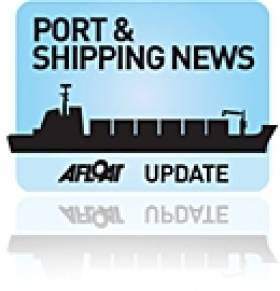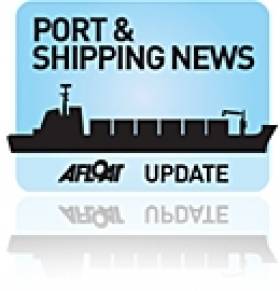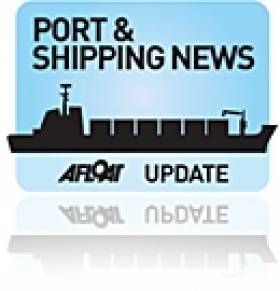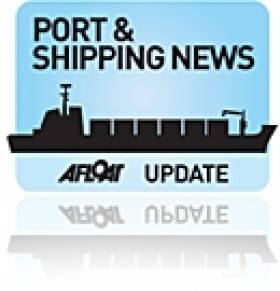Displaying items by tag: IMDO Shipping Review
#Ports&Shipping - The latest IMDO Weekly Market Review includes the following stories as outlined below.
Irish Maritime News: Bantry Harbour €8.5m Plan Gets the Green Light - Bantry harbour is set for a major €8.5m redevelopment which will see a new 20-berth marina, a deeper inner harbour, and a longer and wider pier completed by 2017. It is hoped the newlook harbour can attract cruise ships, and marine tourists, who will be able to berth leisure craft.
Container Market: Cheaper Fuel to Boost Container Shipping - Lower oil prices are reducing the cost of shipping from Asia to the US and Europe as the cost of bunkers fall. Container shipping companies deal with volatile fuel prices by adding a bunker adjustment/fuel surcharge to freight rates, with adjustments made periodically to reflect changes in average fuel consumption, sailing time, vessel capacity and fuel quality changes.
Growing Concerns about Container Liner Shipping Alliances - There are growing concerns among manufacturers, retailers and wholesalers about the long term threats of a concentrated container liner shipping industry through alliances, the European Shippers' Council (ESC) says.
For more of each of the above stories and much more click the IMDO Market Review (Week 17) here.
In addition to further dedicated coverage visit Afloat.ie's Ports & Shipping news.
IMDO Market Review: ‘Box’ Volumes Rise, Record Asia-Europe Price Drop, Transport Tunnels Under Suez, Maersk Megaships $1bn Order and More
#Ports&Shipping –The latest IMDO Weekly Market Review includes the following stories as detailed below.
Irish Ports: Container shipping volumes rose by 9% in Q3 2014 - As previously reported on Afloat.ie, container shipping volumes Lo/Lo, rose by 9% in Q3. Ro/Ro experienced a 6% growth and Break Bulk volumes grew by 16%. This is in contrast however to total traffic volumes through Irish ports which fell by 3% overall in Q3, when compared to the same period last year.
Container Market: Record price drop on Asia-Europe routes - Box prices on the Asia-Europe trade fell nearly 21% this week representing the largest ever weekly decline on the route and effectively eroding recommended increases by carriers at the start of November. Last week's Shanghai Containerised Freight index shows that prices between Asian and European ports fell 20.5%, or $241, to $934 per TEU.
Shipping Lanes: Egypt hires German firm to bore transport tunnels under Suez Canal - Egypt will use machines made by a German firm to bore at least four tunnels under the Suez Canal, part of an $8 billion project to expand the waterway that the government hopes will raise revenues and foreign currency reserves.
International Shipping: Maersk Line plans fresh wave of megaship orders worth $1bn - Maersk Line will defend its position as the world's leading container carrier with a fresh wave of orders for ultra large boxships (ULCs). The liner giant is poised to splash out close to $1bn on its first order for mega size vessels since placing a ground breaking order for "EEE"-class vessels three years ago.
For more on each of the above and other stories click the IMDO Weekly Markets Review (Week 47). In addition to dedicated coverage on Afloat.ie's Ports & Shipping News section.
IMDO Shipping Review: Irish Maritime Forum A Success, European Ports Predict Weaker Growth, New Head at MSC, Surge in Suezmax Newbuilds and Much More
#Ports&Shipping –The latest IMDO Weekly Shipping Market Review includes the following stories as detailed below.
Irish Maritime News: The inaugural Irish Maritime Forum was deemed a successful event by the IMDO, as previously reported on Afloat.ie. The IMDO was delighted to join an exciting line up of speakers on 26 September 2014 for the first Irish Maritime Forum. The event, entitled 'Developing the Dynamic Future of Ireland's Maritime Sector' was hosted by the Port of Cork in partnership with the Irish Ports Association, bringing together industry leaders from across the Maritime sector.
European Ports: Despite Rise in box traffic for "Northern Range" Ports analysts predict weaker growth for 2015 - The latest Global Port Tracker shows that container ports in Europe's northern range ports of Le Havre, Antwerp, Rotterdam, Bremen and Bremerhaven and Hamburg have handled 2.9% more cargo so far this year compared to 2013.
Container Market: Diego Aponte succeeds father as head of MSC -Mediterranean Shipping Co today announced the appointment of Diego Aponte as President and CEO of the world's second largest ocean carrier. Since joining MSC in 1997, Diego has worked in various functions across the business including Line Management where he managed all aspects of the trade. In recent years, Diego has taken more responsibility in the wider running of the company, serving as Vice President.
Tanker Market: Surge in Suezmax newbuild orders, admist increase in Spot Rates. Improved confidence in the suezmax tanker market has prompted a mini surge in newbuilding orders in 2014. Figures from UK tanker broker EA Gibson suggest orders placed so far this year are close to surpassing the total number contracted in the past three years.
For more on each of the above stories and other reports featured on the IMDO Weekly Markets Review (Week 40) click HERE. In addition to Afloat.ie's dedicated Ports & Shipping News coverage.
IMDO Shipping Review: New Dublin Docklands Masterplan, Floating Harbour, Concerns Over EU Port Reform and Much More
#IMDOshippingreview –The latest IMDO Weekly Shipping Market Review includes the following stories as detailed below.
Irish Ports: New Master Plan for Dublin Docklands - The Master Plan is a very comprehensive document covering social regeneration, economic development, land use, transportation, infrastructure, urban design, arts, culture, tourism and leisure. It now has a more realistic approach to developing the docklands in a way that will ensure a balance between commercial and residential.
Global Ports: Floating Harbour Transhipper - A floating harbour transhipper (FHT) is similar to an offshore warehouse. The idea is that cargo is loaded onto the FHT directly at the point of production and brought out to the bigger ships rather than having them come in and docking in port. This idea has evolved from the lightering crane barge, which is already well established in some countries.
ECSA Concerns over EU Port Reform - In a press release earlier this week the European Community Ship Owners Association expressed concerns regarding the watering down of proposed Regulation to establish a framework on market access to port services and financial transparency of ports. Concerns are raised that Member States are contemplating excluding cargo handling and passenger services from the Regulation while the exclusion of pilotage remains uncertain.
For more on each of the above and other stories from the IMDO Weekly Markets Review (Week 39) click HERE. In addition to Afloat.ie's coverage of Ports & Shipping news.
IMDO Shipping Review: EU Sulphur Directive in Maritime Industry,FTA Seek Postcode Reassurance,CEF Transport Calls on Proposals and much more
#Ports&Shipping –The latest IMDO Weekly Shipping Market Review includes the following stories as detailed below.
Irish Maritime Regulation: Directive 2012/33/ EU on Sulphur Emissions in the Maritime Industry- Air pollutant emissions from maritime transport can be transported over long distances and thus increasingly contribute to air quality problems in the EU.
The Thematic Strategy on air pollution from 2005 concluded that sulphur emissions from shipping were forecast to exceed those from all land-based sources in the EU by 2020. Further action is therefore needed to improve human health and the environment.
For latest responses to the Directive from three shipping companies, download the IMDO PDF below and for a copy of the Directive in the Irish Statute book, click HERE.
Irish Ports & Shipping News: FTA seeks reassurance over new postcodes - The Freight Transport Association of Ireland (FTAI) has sought reassurances that Eircode, Ireland's new postcode system, is fit for business. This follows concerns from members that the system appears optimized for the delivery of postal mail, but is not adequate for location or navigation purposes, or for the 'smart' economy. The post code will consist of seven-characters, including a routing key and an identifier unique to each mailing address. The system is designed to be a smart locater capable of identifying any address in the country and is hoped to be rolled out by 2015.
EU Funding: €11.93 billion allocation for 2014 CEF Transport Call - The 2014 CEF Transport Calls for Proposals, published on 11 September 2014, are the first calls under the successor programme to TEN-T.The main objective of CEF Transport is to help complete the TEN-T Core Network and its Corridors by 2030. A total budget of €26.2 billion has been allocated to co-fund TEN- T projects in the EU Member States for the period 2014-2020: more than three times the amount allocated to the predecessor TEN-T Programme (2007–2013).
For more on each of the above and other stories click the PDF downloadable IMDO Weekly Markets Review (Week 37). In addition to coverage on Afloat.ie's dedicated Ports & Shipping News section.
IMDO Shipping Review: Irish Port Volumes 2% Rise, Container Oversupply, Finnlines Profit Boost, Strong VLCC Market and Much More
#Ports&Shipping –The latest IMDO Weekly Shipping Market Review includes the following stories as detailed below.
Irish Maritime Industry - Analysis released – As previously reported on Afloat.ie, Irish shipping and port activity rose by 2% in the second quarter of 2014 when compared to the corresponding period of 2013. The latest quarterly analysis according to iShipIndex also indicates that four of five principal freight segments grew in Q2 of 2014. For a more in-depth analysis click HERE.
Container Market: faces several more years of oversupply - AP Moller-Maersk chief executive Nils Andersen gave a broad ranging interview last week. He warned that Container operators four or five years of surplus capacity before demand catches up with supply is not as severe as some had feared, helped by better-than-expected volume growth in the Asia-Europe trades in recent months. But with an orderbook that still represents some 20% of existing capacity, it will take several years before the industry is back in equilibrium, Mr Andersen said in a telephone interview.
Short Sea Market: Finnlines Poised for Profit Boost as Rivals Suffer From EU Rules - Finnlines Oyj is geared to boost next year's profits as rivals stand to suffer under tighter environmental rules, while its modern ships will sail unhindered through the English Channel and Baltic Sea.
"This is a highly competitive business," Chief Financial Officer Tom Pippingskoeld said in an interview. "Considering our competitors with an older fleet, it may not be economical to install scrubbers on older vessels, since they are expensive. That may improve the market at the start of next year."
Tanker Market: Strong VLCC market looks set to continue - There is a positive outlook for an already strong VLCC spot market, analyst and broker sources have confirmed. DNB Securities' shipping analysts Nicolay Dyvik, Oyvind Berle and Petter Haugen cite a Reuters report, which said oil traders have started fixing crude tankers to bring North Sea, West African and Arab crude oil to South Africa for storage to repeat the super profits enjoyed in 2008-09.
For more of the above and other stories click here for PDF download of IMDO Weekly Markets Review (Week 35). In addition to Afloat.ie's dedicated Ports & Shipping News coverage.
IMDO Shipping Review: Shipping Optimistic Outlook, First Ethane-Fuelled Orders, Irish CEO's Express Confidence and much more
#Ports&Shipping –The latest IMDO Weekly Shipping Market Review includes the following stories as detailed below.
Shipping Industry: Optimistic outlook - A majority of shipping companies expect their turnover and profits to increase during 2014, according to a survey from German shipping lender HSH Nordbank, as reported by Lloyd's List. Of the 51 companies surveyed, 59% reported expectations of increased sales during the current year, with 43% projecting rising profits.
Technology & Innovation: First orders for ethane-fuelled vessels - Three new ethane-powered ships or liquefied ethylene gas carriers (LEGCs) – the first vessels to be powered by ethane – have been ordered by Ocean Yield ASA of Norway, according to Ship & Bunker. Man Diesel, suppliers of the ships' engines, advocates the benefits of ethane as a fuel alternative. They claim ethane is less expensive and requires less bunkering time than heavy fuel oil (HFO).
Irish Economy: CEO confidence rising - A CEO Pulse survey carried out by PwC saw 86% of Irish CEO's expressing their confidence regarding Ireland's economy. The survey was based on the views of 250 CEOs in Ireland and saw an increase of 31% in positivity from CEOs when compared to the same time last year. Despite respondents showing a considerable increase in positive sentiment towards the wider economy and their own businesses, many still reported challenges facing their businesses in the coming years with 86% viewing the increasing tax burden as a major challenge
For more on each of the above and other stories click the PDF downloadable IMDO Weekly Markets Review (Week 30). In addition to coverage on Afloat.ie's dedicated Ports & Shipping News.
IMDO Shipping Review: Ultra-Large Vessel Order Slow, Tanker Carries Cars & Boxes, Shipping Firms Join Sulphur Alliance and much more
#Ports&Shipping –The latest IMDO Weekly Shipping Market Review includes the following stories as detailed below.
Container Market: Ultra-large vessel orders slow - Ordering of new containerships slowed significantly during the month of June, as European traffic demand began to increase, signalling a potential change of fortunes for the sector. Seatrade Global reported that the slowdown in growth of the orderbook, particularly amongst ultra-large vessels, marks a positive sign that improving demand could catch-up with the projected vessel supply by 2016.
Technology & Innovation: Tanker which also carries cars & boxes to set sail - Russian Ship owner BF tanker will take delivery of ten unique tankers that haul oil products, boxes and vehicles, Lloyd's List reported. Designed primarily to carry oil products, the ships will also have the capacity to handle containers and vehicles. The chief executive of BF tanker, Sergey Chaplygin, explained the project as "unique as it can provide backhaul shipments of containers and other general cargoes inincluding oversized industrial equipment."
Regulation: Shipping firms join to ensure sulphur emission compliance- A group of shipping companies with worldwide operations have joined together to form the 'Trident Alliance', aimed at ensuring robust enforcement of stricter sulphur emission standards, TradeWinds reported. The body was formed by ship owners and operators who share a common interest in the clear implementation of current and future marine sulphur regulations.cluding oversized industrial equipment."
For more on each of the above and other stories click the PDF downloadable IMDO Weekly Markets Review (Week 29). In addition to coverage on Afloat.ie's dedicated Ports & Shipping News.
#Ports&Shipping –The latest IMDO Weekly Shipping Market Review includes the following stories as detailed below.
Container Market: Maersk, MSC agree post-P3 vessel sharing agreement - With the failure of the P3 alliance, vetoed by China, Maersk Line and Mediterranean Shipping Company (MSC) have entered a 10-year vessel sharing agreement, Seatrade Global has reported. This agreement, dubbed the 2M agreement, will see the two companies collaborate on Asia-Europe, transatlantic and transpacific routes. The original alliance which also included CMA CGM was rejected by China who saw the agreement between the three largest container carriers in the world as a merger.
Tanker Market: LNG newbuild investment approaches $5bn so far this year - The demand for LNG ships has shot up this year with orders coming to $4.6bn, according to Lloyd's List. Twenty-three contracts for the building of new LNG carriers have been signed so far this year, at a rate of almost one a week. The interest of investors has been attracted by expectations that new cargoes will be introduced into the market once these new ships are in operation.
Logistics: Route approved by Nicaragua for $40 billion canal linking oceans - A $40 billion shipping channel across Nicaragua was approved by a national committee recently, Reuters has reported. The 172 mile route from the mouth of the Brito River on the pacific side to the Punto Gorda River on the Caribbean was proposed by executives from the HK Nicaragua Canal Development Co Ltd and will measure between 230 meters and 520 meters wide and 27.6 meters deep.
For more on each of the above and other stories click the PDF downloadable IMDO Weekly Markets Review (Week 28). In addition coverage of Afloat.ie's Ports & Shipping News.
IMDO Shipping Review: Box Volumes in N. Europe Rise, US Shale Drive LPG Market, Congestion at European Ports and more
#Ports&Shipping –The latest IMDO Weekly Shipping Market Review includes the following stories as detailed below.
Container Market: Box volumes at North European ports to maintain growth - Box traffic in Northern Europe's six largest ports will rise by 6.9% in the latter half of 2014, Lloyd's List has reported. According to the latest Global Port tracker report published by Hackett Associates and the Institute of Shipping Economics and Logistics, imports will increase 5.1% and exports 2.5% throughout Europe during the six-month period.
Tanker Market: US Shale to drive LPG market and tanker demand- Record shipments of liquefied petroleum gas (LPG) from the US, resulting from increasing shale oil production, is set to cause rising tanker demand, Bloomberg has reported. US exports of LPG – used primarily for cooking, heating and in the petrochemicals industry as a feedstock – reached record levels of 506,000 bpd during April, according to the Energy Information Administration (EIA), as production has gradually risen in response to higher oil prices and improved techniques for extraction of gas trapped in shale rock.
Ports: Congestion at European ports set to continue -Rising congestions at North European ports is set to continue as vessel sharing alliances develop, the latest research from Drewry indicates. A number of factors have led to the current congestion, particularly at Rotterdam and Hamburg. Upgrading of existing facilities and larger volume surges resulting from the increased average size of box ships have both placed constraints on terminal capacity.
For more on each of the above and other stories click the PDF downloadable IMDO Weekly Markets Review (Week 27). In addition to coverage on Afloat.ie's dedicated Ports & Shipping News section.

































































